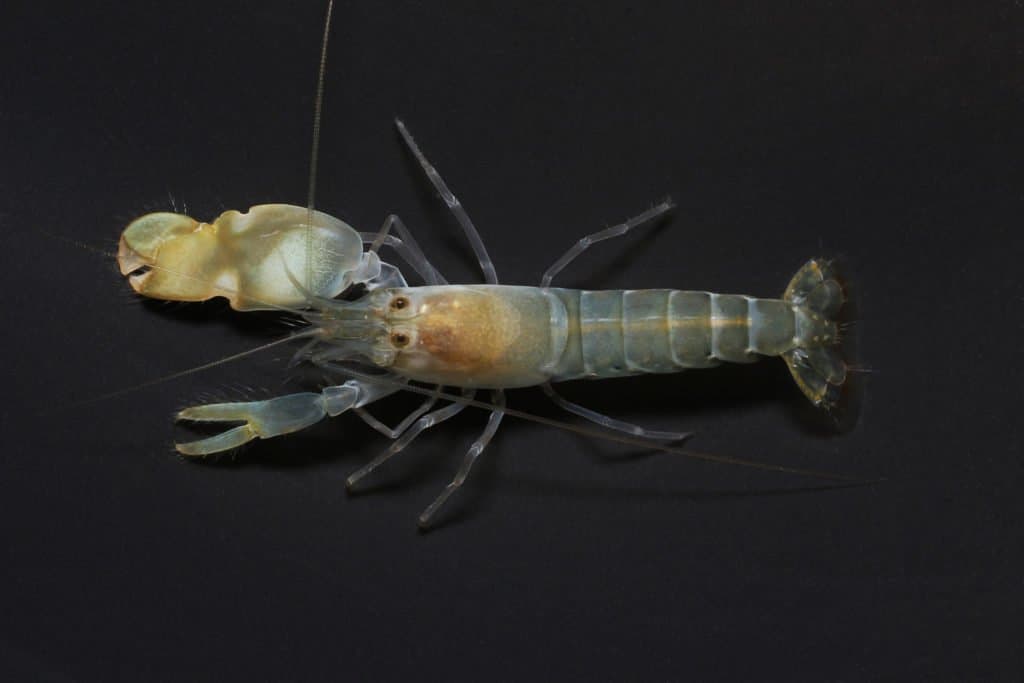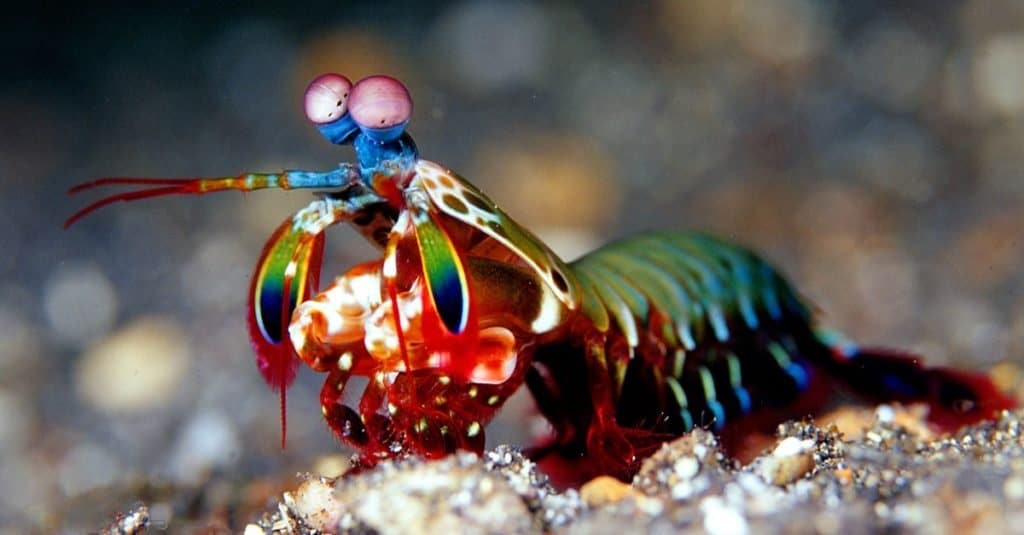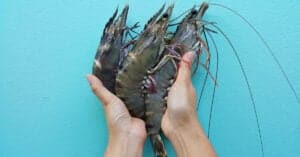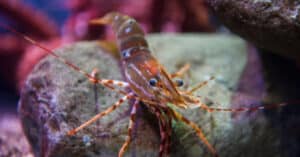When most people think of shrimp, they imagine weak invertebrates that are consumed in massive quantities by other creatures in the ocean, like whales. However, not all shrimp are merely lunch for dolphins, sharks, and starfish. In fact, some shrimp, like the mantis shrimp, are not shrimp at all. Nevertheless, arthropods like the pistol shrimp and mantis shrimp are tough as nails, using their unique bodies to launch devastating attacks. Does that sound too good to be true? Take a few minutes to learn about the differences between a pistol shrimp vs mantis shrimp and see how these creatures measure up to one another.
Comparing a Pistol Shrimp and a Mantis Shrimp

| Pistol Shrimp | Mantis Shrimp | |
| Size | Length: 1.2in-2in | Length: 3.9in -15in |
| Morphology | – Typical shrimp body with several antennae and 10 legs – High asymmetrical body with one side having a massive claw that measures about 1 inch – Often have red and white bodies | – Raptorial appendages – Unique eyes that rise off the head in stalks and can move independently while seeing color, depth, and light polarization. – 8 pairs of legs for scurrying and pleopods on their stomach that help them swim – Numerous colors including bright red, green, and yellow to dull brown. |
| Scientific Name | – Alpheidae – Commonly called snapping shrimp as a family or the “pistol shrimp” | – Stomatopoda – Commonly called the mantis shrimp due to its grasping forelegs that resemble those of a praying mantis |
| Methods of Attack | – Powerful “snapping” effect, where the claw is “cocked” like a pistol and then snaps closed to produce a weaponized bubble. – Using their unique claw, the pistol shrimp emits a powerful cavitation bubble that stuns or kills other creatures – Bubble moves at 62 mph and generates temperatures over 5,000K – Produces 200 decibels of sound, a noise so loud that groups of these shrimp can interfere with sonar | – Highly developed and distinctive eyes detect creatures in the water. – Have two methods of attack – Smash their foe with a hardened claw, a piece of their body that has a sharp edge – Spear their foes with their raptorial forelegs that dig into prey and kill them – One of the fastest attacks in all of the animal kingdom, 51 mph, resulting in cavitation like the pistol shrimp |
| Hunting Style | Mostly opportunistic | Ambush predators and opportunistic predators that hide in burrows and then attack creatures that come by |
| Danger to Humans | No recorded injuries to humans | – Can cause injuries to fingers and hands when handled – Called the “thumb splitter shrimp” |
The Key Differences Between Pistol Shrimp vs Mantis Shrimp

Pistol shrimp have one oversized claw that they use to devastating effect
©Matthew R McClure/Shutterstock.com
The greatest differences between pistol shrimp and mantis shrimp are their families, methods of attack, and morphology. Pistol shrimp, also called Alpheidae, are true shrimp, but mantis shrimp (Stomatopoda) are not actually shrimp. Pistol shrimp use their unique claws to generate a weaponized bubble that slams into creatures, but mantis shrimp use a spear or hammer to stab or smash their foes.
The pistol shrimp resembles many other types of shrimp with the exception being the enlarged claw that it uses to generate its powerful attacks. However, the mantis shrimp more closely resembles a small lobster and possesses praying mantis-like raptorial forelegs that it uses to spear or smash prey.
These are the most significant differences between these creatures.
Pistol Shrimp vs Mantis Shrimp: Size
Mantis shrimp are larger than pistol shrimp. The average pistol shrimp is 1.2 inches to 2 inches in length, but a mantis shrimp can measure anywhere between 3.9 inches and 15 inches.
Pistol Shrimp vs Mantis Shrimp: Morphology

Mantis Shrimp more closely resemble a lobster than shrimp!
©Richard Whitcombe/Shutterstock.com
The pistol shrimp usually has the same red and white colors common in most of its species, possesses 10 legs like other decapods, and has an asymmetrical body with one large claw that can measure half of its total length.
Mantis shrimp have 8 pairs of legs along with pleopods that they use to swim and scurry along the ocean floor. They come in a variety of colors and are known for their raptorial forelegs that they keep tucked but ready along with their eyes that are raised off their head by stalks.
Pistol Shrimp vs Mantis Shrimp: Scientific Name
The pistol shrimp is known as Alpheidae, and they are sometimes called the “snapping shrimp.” Mantis shrimp are known as Stomatopoda, and they are known for their forelegs that resemble the praying mantis.
Pistol Shrimp vs Mantis Shrimp: Methods of Attack
Pistol shrimp are powerful creatures that can use their claws to generate powerful attacks underwater. They cock their claws like a pistol and then unleash the blast, emitting a cavitation bubble that produces a 200-decibel burst, temperatures that reach thousands of Kelvins, and a force that hits 62 mph, stunning or outright killing their foes.
Mantis shrimp hunt their foes using their amazing vision. They come in two varieties: smashing or spearing. The spearing mantis shrimp uses its sharp raptorial claws to launch an attack at 51 mph, stabbing its prey and leading to cavitation. Even if it misses, its cavitation shockwave can kill its prey.
Mantis shrimp might not use their raptorial legs as spears; some have a hardened “club” on their “arms” that launches a powerful smashing attack. Either way, their prey is quickly overwhelmed by their attacks.
Both the pistol shrimp and mantis shrimp are unique, powerful creatures.
Pistol Shrimp vs Mantis Shrimp: Hunting Style
Pistol shrimp are mostly opportunistic, but mantis shrimp are ambush predators and opportunistic predators. The latter will actively hunt for food from its burrow or while searching for a new place to stay, but pistol shrimp have poor vision, so they encounter food and kill it while moving throughout a territory.
Pistol Shrimp vs Mantis Shrimp: Danger to Humans
Pistol shrimp are not dangerous to humans. At least, no records of injuries to humans exist because they can’t create the cavitation bubble outside of the water where they encounter humans most often.
Mantis shrimp are known as “thumb splitter shrimp”, and they earned that name. These arthropods can and will attack humans when they’re handled. They can puncture the skin and tear flesh with ease, but they won’t kill a person.
Pistol Shrimp vs Mantis Shrimp: Which One Would Win a Fight?

A mantis shrimp is too large and fast for a pistol shrimp to handle.
©iStock.com/worldclassphoto
A mantis shrimp would win a fight because it is much too large and well-armored for a pistol shrimp to knock out right away. A pistol shrimp can fight above its weight, but a large mantis shrimp has too many advantages aside from its defenses.
The most likely result of such a fight would see a pistol shrimp wandering into the wrong part of the water, and the mantis shrimp would burst out of its burrow and stab or club the smaller creature to death before it could react.
If the two were forced to fight in open water, the battle would come down to which creature could land the first strike. A pistol shrimp against a mantis shrimp of a similar size has the range advantage, but mantis shrimp can move very fast and that could give them the edge to minimize the damage of a bubble shot and then counterattack.
Given these elements, the mantis shrimp has the advantage and would probably win the fight.
The photo featured at the top of this post is © Subphoto.com/Shutterstock.com
Thank you for reading! Have some feedback for us? Contact the AZ Animals editorial team.






